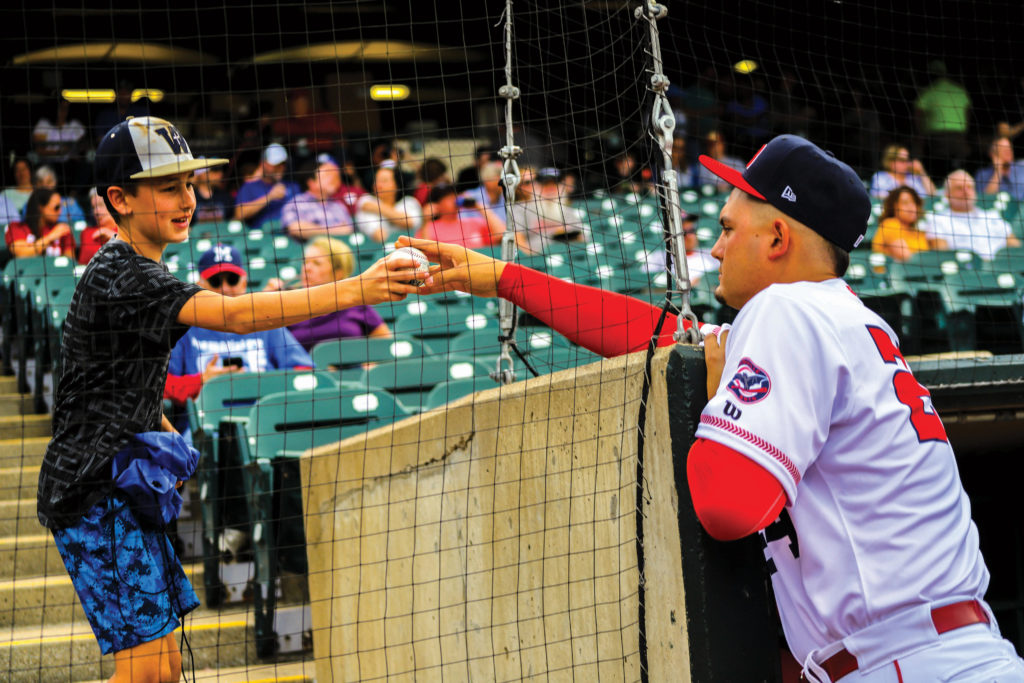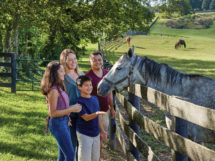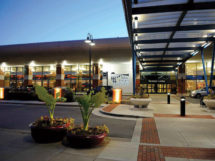
The Kentucky Derby has always been one of the nation’s elite sporting events. But when those 20 Thoroughbreds took to the field on the first Saturday in May 2021, the whole country was watching for another reason: It was the largest sporting event held in the U.S. since pandemic restrictions began in March of 2020, and many were anxious to see how it would go.
 “The whole country was watching,” said Louisville Mayor Greg Fischer. “People were tired of winter and tired of the pandemic, too. The pandemic was like one big, long winter. It felt good to see people in person and chat and catch up. I think everybody had a pretty nice sigh of relief and said, ‘OK, we’re getting back more toward normal.’”
“The whole country was watching,” said Louisville Mayor Greg Fischer. “People were tired of winter and tired of the pandemic, too. The pandemic was like one big, long winter. It felt good to see people in person and chat and catch up. I think everybody had a pretty nice sigh of relief and said, ‘OK, we’re getting back more toward normal.’”
The 2020 Kentucky Derby was postponed until Labor Day weekend because of the pandemic. On the day of the race, Churchill Downs was uncharacteristically deserted as the Derby was run without fans. This year, capacity was significantly reduced from the usual 150,000-plus. Derby Day saw a crowd of 51,838; the day before, 41,472 had watched the Oaks.
The Derby, Oaks and surrounding festivities produced an economic boost that was welcomed by Louisville tourism officials after last year’s drastic falloff. Stacey Yates, vice president of marketing and communications for Louisville Tourism, estimated the economic impact at about $35 million – far less than the approximate $400 million the events normally generate, but a boost nonetheless.
The industry formula for determining economic benefits factors in numerous criteria, including Derby attendance and hotel occupancy and room rates.
Despite the crowd limitation, Yates told reporters that the Derby will still be the biggest show in town for 2021, with the next closest event in estimated economic impact being the GIE+ Expo, a landscape and outdoor living expo set for Oct. 20-22, which is projected at $19 million.
‘Extensive adjustments to what was once routine’
The return of the Derby with fans and Churchill Downs’ ability to bring it off without a hitch bodes well for the future of other sports activities and events in Kentuckiana this year.
“Sporting events are happening – locally and nationally – at the youth level and in high schools, colleges and the pros,” said Karl Schmitt, president and CEO of the Louisville Sports Commission. “Athletes, coaches, trainers, officials, administrators and spectators are making extensive adjustments to what was once routine and regular.”
Schmitt said the Louisville Sports Commission worked in partnership with Louisville Tourism and numerous local and national sports organizations to develop plans for how the community could continue to host sporting events in a safe and responsible manner.
In the early days of the pandemic, Schmitt said Louisville lost “scores of events,” but this year many travel sports events have resumed. Baseball, softball, cross-country, cycling, and cheer and dance events were the first sports to be approved for competition. Travel volleyball returned early this year, as did track and field meets.
“Sports provide a positive jolt to our physical and mental health, offer entertainment value and balance in the midst of such uncertainty, and are an important boost to the economy,” Schmitt added. “At this point in our history, sports are not a luxury, they are a lifeline.”
From the standpoint of generating hotel room nights, Schmitt noted that the sports market has been a leader during the pandemic and will continue to do so. He said the Sports Commission also recognizes that the pandemic has further reduced opportunities for youth in economically disadvantaged neighborhoods to participate in sports. In response, the commission has ramped up its youth initiatives to help mitigate that problem.
The opening of the new Norton Healthcare Sports and Learning Center in Louisville’s West End, a $53 million Louisville Urban League project, is helping address some of those needs. Twelve track meets were held there in February and March, and other events are scheduled.
The center features a 200-meter indoor track, a 400-meter outdoor track, a rock-climbing wall, a mini bowling alley and educational spaces.
“The sense of accomplishment is overwhelming,” said Sadiqa Reynolds, CEO of the Urban League. “I think it says a lot about us as a city and an organization and I am proud the teamwork; so many people helped.”
On the collegiate end, in May the University of Louisville doubled its attendance level to 50% (2,000) at Jim Patterson Stadium for baseball, and the school’s football and basketball teams will likely play in front of thousands more than last season. The Cardinals were limited to 12,000 (18%) for football games in Cardinal Stadium in 2020 and to 3,000 in the 22,000-seat Yum! Center for basketball until it was raised to 5,000 near the end of the season.

With universities trying to entice fans back into the stands, UofL athletic director Vince Tyra says he is being conservative by planning for 75% to 80% season ticket renewal for football.
Also at UofL, LG&E and Commonwealth Credit Union this spring became founding partners of the student-run esports organization, which currently has more than 10 teams competing against other colleges in the U.S. through seasonal play and tournaments.
“As a complement to our existing support of UofL, we recognize the growing popularity of college esports, particularly during this past year with the pandemic and quarantine protocols,” said Chris Whelan, LG&E vice president of communications and corporate responsibility. “We’re proud to support education and this technology-based sports organization in this new venture.”
Each new semester contributes to the growth of more teams, playing League of Legends, Rocket League, Valorant and other popular games. Last year, UofL esports won the inaugural Virtual Governors Cup against the University of Kentucky.
Meanwhile, Louisville’s three professional sports teams have been gearing up for a bigger and better summer in 2021.
In May, the Louisville Bats played their first game in 610 days after the 2020 Minor League season was canceled. A semi-restricted crowd of 5,000 was on hand in 13,131-seat Slugger Field in what Mayor Greg Fischer called “a great lift for the city.”
Since the 2019 season, the stadium has undergone a $7 million renovation including new seats, two new bars, a new playground and new LED video boards.
“It’s pretty exciting,” said Greg Galliatte, Bats executive vice president. “You can just feel the magic in the air. We’re looking forward to putting on a great show.”
Louisville City FC wasn’t able to start its 2020 season until July 12, but this year kicked off on time in late April at Lynn Family Stadium in front of 7,652 fans, the 50% capacity allowed at the time. LouFC is operating another club, Racing Louisville FC, which played its first home game to a sold-out crowd of 5,300.
Racing marks the return of top-tier pro sports to Louisville for the first time since the Kentucky Colonels folded in 1976. In just its second year of existence, Lynn has already hosted multiple U.S. Women’s National Team members and also Marta Vieria de Silva, a Brazilian legend. Racing Louisville FC is a member of the National Women’s Soccer League (NWSL), regarded as the best in the world.
Region rich with outdoor recreational opportunities
Kentuckiana also offers plenty of opportunities for those who prefer outdoor recreation and connecting with nature.

The crown jewel of parks is The Parklands of Floyds Fork in the eastern and southeastern part of the city. Still being developed, the $120 million project includes four major parks covering nearly 4,000 acres linked by a park drive, a first-rate urban trail system and a water trail, all tracing Floyds Fork. It is five times larger than New York’s Central Park and is one of the largest donor- and visitor-supported public park systems in the country.
Featured in the development is the Louisville Loop, a 100-mile multi-recreational, non-motorized path that will eventually encircle the city and link neighborhoods. The loop will connect five regions of the city, each with distinct geology, topography, plant and animal communities, and history. Two of the five are open and ready to be explored: the Ohio River Valley and Floyds Fork.
Another major outdoor recreation area is Bernheim Arboretum and Research Forest, the largest privately held forest dedicated to conservation and education in the eastern U.S. Located near Clermont, the forest contains over 40 miles of trails through knobs and valleys, ridges and hollows.
Three Southern Indiana counties offer smaller forests and two state parks within less than an hour from Louisville.
Other recreational opportunities in the region include Harrison-Crawford State Forest near Corydon, Ind., 24,000 acres bordering the Ohio River featuring numerous trails for hikers and bikers; O’Bannon Woods State Park; and Clark State Forest, the oldest state forest in Indiana, consisting of 24,000 acres that includes seven lakes and a shooting range.
Click here for more Kentucky business news.



















